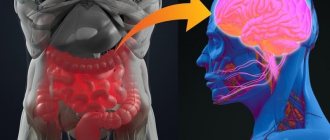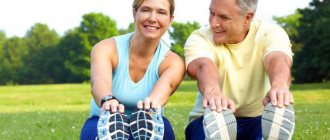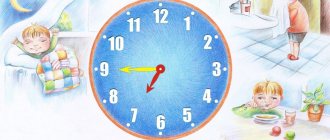Human physical health is the natural state of the body, determined by the normal functioning of all its organs and systems. Stress, bad habits, unbalanced nutrition, lack of physical activity and other unfavorable conditions affect not only the social sphere of human activity, but also cause the appearance of various chronic diseases.
To prevent them, it is necessary to lead a healthy lifestyle, the basis of which is physical development. Regular fitness classes, yoga, running, swimming, skating and other types of physical activity help keep the body in good shape and help maintain a positive attitude. A healthy lifestyle reflects a certain life position aimed at developing culture and hygiene skills, maintaining and strengthening health, and maintaining an optimal quality of life.
Factors in human physical health
The main factor in a person’s physical health is his lifestyle.
A healthy lifestyle is reasonable human behavior, including:
- Optimal ratio of work and rest;
- Correctly calculated physical activity;
- Rejection of bad habits;
- Balanced diet;
- Positive thinking.
A healthy lifestyle ensures the full implementation of social functions, active participation in the labor, social, family and household spheres, and also directly affects life expectancy. According to experts, a person’s physical health depends on lifestyle by more than 50%.
Factors of environmental influence on the human body can be divided into several impact groups:
- Physical - humidity and air pressure, as well as solar radiation, electromagnetic waves and many other indicators;
- Chemical – various elements and compounds of natural and artificial origin that are part of air, water, soil, food products, building materials, clothing, electronics;
- Biological – beneficial and harmful microorganisms, viruses, fungi, as well as animals, plants and their metabolic products.
The impact of the combination of these factors on a person’s physical health, according to experts, is about 20%.
To a lesser extent, health is influenced by heredity, which can be either a direct cause of diseases or take part in their development. From a genetic point of view, all diseases can be divided into three types:
- Hereditary are diseases, the occurrence and development of which is associated with defects in inherited cells (Down syndrome, Alzheimer's disease, hemophilia, cardiomyopathy and others);
- Conditionally hereditary - with a genetic predisposition, but provoked by external factors (hypertension, atherosclerosis, diabetes, eczema and others);
- Non-hereditary - caused by environmental influences and not related to the genetic code.
All people have a genetic predisposition to various diseases, which is why doctors are always interested in the diseases of the patient’s parents and other relatives. The influence of heredity on a person’s physical health is estimated by researchers at 15%.
Medical care, according to expert data, has almost no effect on health (less than 10%). According to WHO research, the main cause of both deterioration in quality of life and premature death are chronic diseases, which can be divided into four main types:
- Cardiovascular (heart attack, stroke);
- Chronic respiratory (obstructive pulmonary disease, asthma);
- Oncological;
- Diabetes.
The development of chronic diseases is promoted by alcohol consumption, smoking, unhealthy diet and lack of physical activity.
Consequently, the main indicator of a person’s physical health is a lifestyle that should be aimed at preventing diseases, promoting health, and achieving spiritual and physical harmony.
Key Facts
- Physical activity provides significant benefits for maintaining a healthy heart, brain, and overall body health.
- Physical activity contributes to the prevention and treatment of non-communicable diseases such as cardiovascular diseases, cancer and diabetes;
- reduces symptoms of depression and anxiety;
- improves thinking, learning, and critical evaluation skills;
- promotes healthy growth and development of youth;
- and improves overall well-being.
What is physical activity?
According to WHO definition, physical activity is any movement of the body produced by skeletal muscles that requires energy expenditure. The term “physical activity” refers to any type of movement, including during leisure, traveling to and from places, or while working. Both moderate and vigorous physical activity contribute to improved health.
Popular physical activities include walking, cycling, roller skating, sports, outdoor activities and games that are suitable for all skill levels and are fun for everyone.
Regular physical activity has been shown to help prevent and treat non-communicable diseases such as heart disease, stroke, diabetes and some types of cancer. It also helps prevent hypertension, maintain healthy body weight and may improve mental health, quality of life and well-being.
Human physical development and health
The basis of a healthy lifestyle is the physical development of a person, and health directly depends on the optimal balance of physical activity and rest. Regular exercise provides a high level of immunity, improves metabolism and blood circulation, normalizes blood pressure, and increases strength and endurance. When planning physical activity, it is imperative to take into account the age and physiological characteristics of the person, take into account the state of health, and consult a doctor about possible contraindications. Loads must be optimal: insufficient - ineffective, excessive - harm the body. In addition, over time, the loads become habitual and need to be gradually increased. Their intensity is determined by the number of repetitions of the exercises, the range of movements and the pace of execution.
The concept of “physical health”
Physical health is the most important component in the complex structure of human health. It is determined by the properties of the organism as a complex biological system. As a biological system, an organism has integral qualities that its individual constituent elements (cells, tissues, organs and organ systems) do not possess. Without connection with each other, these elements cannot support individual existence.
In addition, the organism has the ability to maintain individual existence through self-organization . Manifestations of self-organization include the ability to self-renewal, self-regulation and self-healing.
Self-renewal is associated with the constant mutual exchange of matter, energy and information between the body and the external environment. The human body is an open system. In the process of self-renewal, the body maintains its orderliness and prevents its destruction.
Physical health is determined by the body's ability to self-regulate. Perfect coordination of all functions is a consequence of the fact that a living organism is a self-regulating system. Self-regulation is the essence of the biological form of development, i.e. life. This general property of biological systems makes it possible to establish and maintain at a certain, relatively constant level certain physiological-biochemical or other biological indicators (constants), for example, constancy of body temperature, blood pressure, blood glucose levels, etc. Maintaining the degree orderliness is manifested in the relative dynamic constancy of the internal environment of the body - homeostasis (homeostasis; Greek homoios - similar, similar + stasis - standing, immobility).
More than 100 years ago, the outstanding French scientist Claude Bernard first raised the question of the meaning of homeostasis (although the term itself was introduced later by W. Cannon). In his first works on homeostasis, V. Cannon noted that living beings are an open system with many connections with the environment. These connections are made through the respiratory and digestive tracts, superficial skin receptors, neuromuscular organs and bone levers. Changes in the environment directly or indirectly affect these systems, causing corresponding changes in them. However, these effects are usually not accompanied by large deviations from the norm and do not cause serious disturbances in physiological processes due to the fact that automatic self-regulation limits the fluctuations that occur in the body within relatively narrow limits. To designate this relative constancy the term “equilibrium” or “equilibrium” could be used. This term is quite suitable for relatively simple physical or physicochemical processes. However, in a complex living organism, in addition to balancing processes, integrative cooperation of a number of organs and systems is usually included. So, for example, when conditions are created that change the composition of the blood and cause disruption of respiratory functions, the brain and nerves, heart, lungs, kidneys, spleen, etc. quickly react. To designate such phenomena, according to Cannon, the term “balancing” is insufficient; since the coordination of physiological reactions is a complex and very specific process. It was for these states and processes that ensure the stability of the body that Cannon proposed the term homeostasis - “homeostasis”.
In his interpretation of this term, V. Cannon emphasized that the word stasis implies not only a stable, immobile, or stagnant state, but also a condition that obviously leads to these phenomena. The word homeo does not indicate identity (same), that is, not some permanently fixed or rigid state, but rather the similarity of phenomena (like or similar). V. Cannon pointed out that in mechanics the term statics is adopted, characterizing a stable state that arises under the influence of certain forces. However, he deliberately refused the word “statics,” considering it inappropriate, since in the phenomena of homeostasis the physiological mechanisms are so specific and so diverse that they have nothing similar to the term “statics” used in technology.
Thus, the term “homeostasis” does not mean the simple constancy of the chemical or physicochemical properties of the organism. With this term, V. Cannon primarily designated the physiological mechanisms that ensure the stability of living beings. This special stability is characterized by the instability of processes - they are constantly changing, but under “normal” conditions, fluctuations in physiological indicators are limited to relatively narrow limits. The phenomena of homeostasis can serve as a good biological example of the dialectical unity of opposites: constancy and variability.
Characterizing the historical basis of the doctrine of homeostasis, it should be said that the phenomenon of homeostasis. In essence, it is an evolutionarily developed, hereditarily fixed adaptive property of adapting the organism to normal environmental conditions. However, these conditions can briefly, and sometimes for a relatively long time, go beyond the “norm”. In such cases, adaptation phenomena are characterized not only by the restoration of the usual properties of the internal environment, but also by a short-term change in functional activity (for example, an increase in the rhythm of cardiac activity and an increase in the frequency of respiratory movements with increased muscle activity). With prolonged or repeated exposure, more permanent and even structural changes may occur, for example in the form of myocardial hypertrophy with increased cardiac workload. When any organs are damaged, compensation mechanisms are activated or vicarious functions arise with the participation of other body systems (for example, increased function of the sweat glands with decreased kidney function). Such processes also represent adaptation to unusual or extreme conditions in the external or internal environment of the body. Thus, it is possible to distinguish between the phenomena of short-term and long-term adaptation.
The biological characteristics of homeostasis are determined not only by the duration of adaptation processes, but also by their significance. Reactions that ensure homeostasis can be aimed at maintaining known levels of a steady state, at coordinating complex processes to eliminate or limit the action of harmful factors, at developing or maintaining optimal forms of interaction between the organism and the environment in the changed conditions of its existence. All these processes determine adaptation.
We have already noted that the self-organization of a biological system is also manifested in the ability to self-heal. This quality is due, first of all, to regeneration, as well as the presence of multiple parallel regulatory influences in the body at all levels of its organization. Compensation for insufficient functions due to these parallels allows the body to survive in conditions of damage, the measure of compensation in this case reflects the level of vitality - its physical health.
Physical health is the current state of the structural elements of the whole organism (cells, tissues, organs and organ systems of the human body), the nature of their interaction and interaction with each other. The material basis for the formation of physical health is the biological program of the individual development of the human body. It is mediated by the basic needs that dominate a person at various stages of the individual development of the body (ontogenesis). Basic needs, on the one hand, serve as a trigger for human biological development (the formation of his physical health), and on the other hand, they ensure the individualization of this process.
In its most general form physical health is the state of the human body, characterized by the ability to adapt to various environmental factors, the level of physical development, and the physical and functional readiness of the body to perform physical activity.
Physical culture and human health
Physical culture is a sphere of social activity aimed at strengthening health and developing a person’s physical abilities. Therefore, doctors especially emphasize the connection between physical culture and human health. There are several types of physical education:
- Basic – aimed at acquiring basic vital physical qualities;
- Sport is a competitive activity based on the use of physical exercises;
Wellness and rehabilitation is the use of physical exercise as treatment and restoration of body functions (therapeutic and adaptive physical education);- Hygienic - various forms of physical education within everyday life (morning exercises, walks and other exercises not associated with significant stress);
- Recreational – tourism, weekend hikes, physical education and sports entertainment.
The last two types are especially important, as they quickly normalize the body’s condition and contribute to the creation of favorable living conditions.
A healthy lifestyle is the most important indicator of a person’s physical health. Leading it means, on the one hand, maintaining social activity and a positive attitude towards the world, and on the other hand, giving up bad habits, balancing your diet and doing regular exercise. Physical education provides motivation to prevent diseases, maintain the body in good physical shape, and increase life expectancy. Physical exercise improves mood, increases self-esteem and relieves stress, increases performance and has a beneficial effect on the functioning of the body as a whole.
Video from YouTube on the topic of the article:
How to increase physical activity?
To increase levels of physical activity, countries and communities must take action to provide more opportunities for everyone to be active. This requires collective efforts at both national and local levels, across a wide range of sectors and disciplines, to implement policies and solutions that take into account national cultural and social conditions and aim to promote, encourage and encourage physical activity.
Policies to increase physical activity levels include:
- providing the entire population with opportunities for walking, cycling, and the use of various types of active non-motorized transport, and ensuring general safety;
- implementing labor and employment policies that encourage active transportation to work and opportunities for increased physical activity during the workday;
- creation of comfortable and safe areas and premises in kindergartens, schools and higher educational institutions, where children, pupils and students could actively spend their free time;
- Providing quality physical education in primary and secondary schools that helps children develop behaviors that will keep them physically active throughout their lives;
- providing opportunities for those of any age and any level of physical fitness to participate in community and school sports programs;
- the creation of sports and recreational facilities where everyone could engage in various sports, dance, physical exercise and active recreation; And
- provision of advice and support to patients by medical professionals to ensure their regular physical activity.









